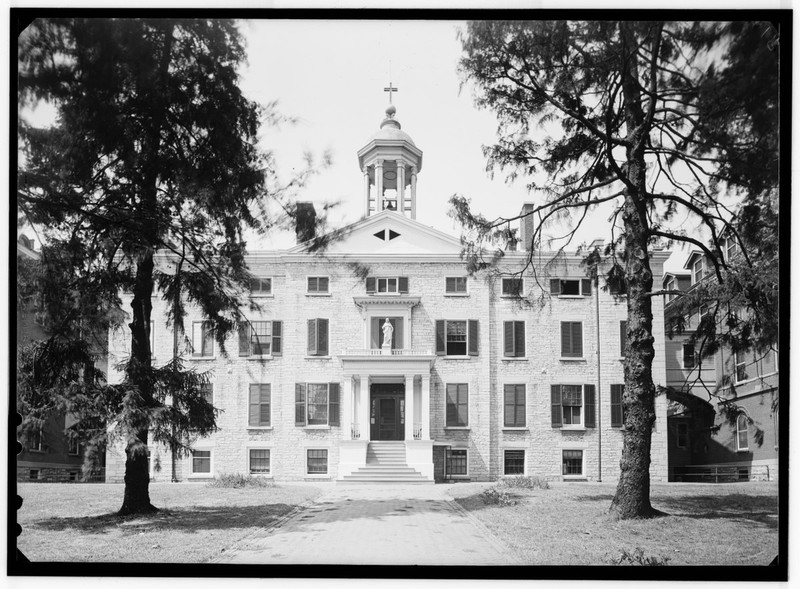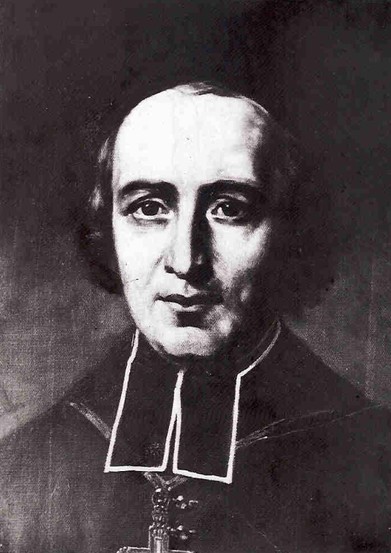St. Stanislaus Seminary
Introduction
Text-to-speech Audio
St. Stanislaus Seminary comprises six educational and residential buildings, three of which were built in the nineteenth century and three of which were built in the twentieth century. The Rock Building faces east-northeast away from the quadrangle and remains almost entirely unaltered. This three-and-a-half-story limestone block building was constructed in 1849 in the Federal style of architecture and was the first permanent building. The buildings on the north and south side of the Rock Building are the Juniorate and Tertian buildings which were constructed between 1898 and 1900 as residences and school facilities for missionaries being trained there. All of the buildings were constructed using labor from Jesuit brothers, novices, and enslaved people. Before the construction of these buildings, simple wooden structures were used for instruction. The seminary was first used as a school for Native American children to be ministered to by Jesuit missionaries with the purpose of assimilating them into European-American culture. The seminary was closed by The Society of Jesus in August of 1971 as they decided to focus on more urban areas. The Society still maintains the buildings as a museum of Jesuit instruction.
Images
St. Stanislaus Seminary c. 1936

Bishop DuBourg

Father Pierre Jean DeSmet

Backstory and Context
Text-to-speech Audio
The seminary was established in 1823 by the Bishop of Louisiana, Bishop Louis William Valentine Dubourg. Bishop Dubourg was born in Santo Domingo on February 16th, 1766. He was ordained in Paris in 1790 but fled France during the French Revolution and arrived in Baltimore in 1794. In 1812, he was appointed as ecclesiastical administrator and sent to New Orleans where he was harassed for his royalist leanings and opposition to Napoleon, so he eventually moved to Rome in 1815. He was made Bishop of Louisiana and the Floridas by Pope Pius VII but decided to move to St. Louis to avoid further harassment.
Bishop Dubourg had conceived of the idea to open a mission school for Native Americans in the Missouri River Valley region after speaking with the secretary of war John C. Calhoun. They viewed the school as a means of “civilizing” the Native American tribes, particularly the Osage tribe, in the region by converting them to Christianity and forcing them to assimilate into white culture. In a letter to Secretary Calhoun, Bishop Dubourg said the seminary would be used to study “the manners of the Indians…and the arts best adapted to the great purpose of civilisation.” Jesuits had previously been going into Missouri to proselytize and baptize members of the Osage tribe under Bishop Dubourg’s reassurance to President Monroe that this would make the Native Americans loyal to America. Because this plan coincided with President Monroe’s interest in assimilating Native Americans, Secretary Calhoun promised financial assistance for the seminary. This promise caused Bishop Dubourg to offer his farm in Florissant to any Jesuit province willing to go to Missouri and minister to Native Americans at the school. Volunteers from the Whitemarsh Novitiate in Maryland agreed to come to Missouri and they arrived on May 23rd, 1823 with Father Charles Felix VanQuickBorne. They established the first Indian School of the Louisiana Purchase.
After 1830, the seminary began to decline mostly due to the fact that the government never fulfilled its promises to provide financial assistance. It was also affected by westward expansion as Native Americans were pushed South or West and were rarely seen in St. Louis following 1830. The seminary stopped functioning as a school for Native Americans and instead turned its focus to preparing missionaries for mission trips out West. The seminary flourished throughout the 1840’s as Jesuits who were exiled from Spain, Portugal, and France for opposing political Absolutism and the Enlightenment arrived to train there. Some of the most prominent Jesuit missionaries trained at the seminary, including Father Pierre Jean DeSmet, who had arrived with Father VanQuickBorne. Born on January 30th, 1801 in Belgium, Father DeSmet went to America in August 1821 and began his novitiate at Whitemarsh. He was transferred to St. Louis eighteen months later. From 1824 to 1830, he was a prefect at St Regis Seminary, a school for Native American boys, where he learned about Native American customs. In 1827, he was ordained at Florissant and in 1840 he was sent as a missionary to the Potawatomi in Council Bluffs, Iowa. He is remembered now for his extensive work as a missionary to Native American tribes in the Rocky Mountains and Canada as well as persuading Sitting Bull to accept the Treaty of Fort Rice. He died in 1873 and was buried at Florissant.
Sources
National Register of Historic Places Nomination Form, MO State Parks. Accessed October 4th, 2022. https://mostateparks.com/sites/mostateparks/files/St.%20Stanislaus%20Seminary.pdf.
DuBourg, Louis Guillaume Valentin, Mound City on the Mississippi. Accessed October 4th, 2022. https://dynamic.stlouis-mo.gov/history/peopledetail.cfm?Master_ID=1268.
Hodes, Fred. St. Louis's First Bishop, A History of St. Louis. August 25th, 2020. Accessed October 4th, 2022. https://www.stlhistories.com/post/st-louis-s-first-bishop.
De Smet, Pierre-Jean, Dictionary of Canadian Biography. Accessed October 4th, 2022. http://www.biographi.ca/en/bio.php?id_nbr=4944.
National Register of Historic Places
St. Louis Historic Preservation
Encyclopedia of the Great Plains
